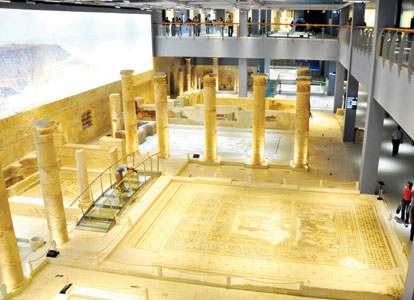The Zeugma Mosaic Museum, which opened Sept. 9 in Gaziantep, was visited by 3,000 people on the first day, a record number of visitors. The museum’s most popular piece is the Gypsy Girl mosaic, officials say.

The Zeugma Mosaic Museum was visited by 1,288 people paying 5 Turkish Liras to enter on its first day while some 1,800 people, including children under 18 and those above 65, visited the museum for free. Museum officials said this number of visitors on a single day was a record, adding that they expected some 100,000 visitors monthly with growing interest from local and foreign tourists.
The Zeugma Mosaic Museum’s enclosed area of 30,000 square meters displays a total of 1,700 square meters of mosaics in more than 7,000 square meters of exhibition halls. Museum officials said the dimensions are greater than Tunisia’s Bardo Museum, which is known as the world’s largest mosaic museum.
Besides mosaics, wall paintings, fountains, columns and walls have been unearthed during various excavations at the site of the ancient Roman city of Zeugma and are now displayed in their original sizes. The ground floor of the museum exhibits a statue of the god of war, Mars, from the first century. The entrance floor exhibits mosaics unearthed in villas on the coast of the River F?rat.
According to officials, the first question visitors ask is about the Gypsy Girl mosaic, which is the symbol of both Gaziantep and Zeugma. The mosaic is displayed in a special section on the museum’s second floor, officials said, adding that almost all visitors ask them: “Is the Gypsy Girl that small?”
On the wall of the labyrinth-shaped room the Mainad mosaic has been displayed, despite being largely destroyed by illegal excavators. Along with the Gypsy Girl, church mosaics from the Eastern Roman period are on displayed on the same floor. The mosaics give the effect of movement and draw great interest from people.
In many parts of the museum, the impact of damage that treasure hunters made on mosaics is being highlighted. In the Dionysos mosaic, which depicts a wedding scene, the photos are used to represent the missing parts of the mosaic and it is told that those parts have yet to be recovered.
The Zeugma Museum received interest from Italian, French, German and Japanese tourists as well as Turks.
Gaziantep Culture and Tourism Director Salih Efiloglu said the museum met world standards in terms of security and lighting technology, adding that 2,600 square meters of mosaics have been so far unearthed in Zeugma excavations. “The mosaics from the Roman period have been completely restored by Turkish teams and they are being exhibited in chronological order,” he said, adding that the restoration of other mosaics is ongoing.
“Gaziantep becomes the mosaic center of the region thanks to this museum,” Efiloglu said, adding that the museum included five conference halls, a depot, an archive and library, gift production craft shops, an art workshop for children, car parking facilities and an archaeological artworks and restoration center.
Source: Hurriyet Daily News [September 14, 2011]